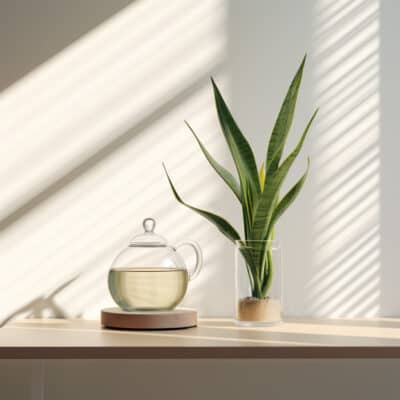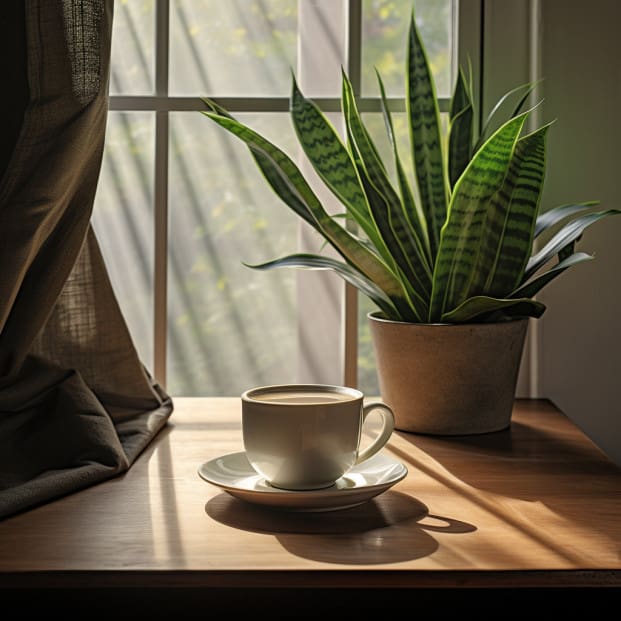You may think a snake plant is an easy, carefree houseplant.
But keeping your snake plant healthy and thriving takes more than just occasional watering.
The secret is in the soil.
Giving your snake plant the right nutrients boosts its growth and vibrant green coloring.
Skip the chemical fertilizers – homemade tea leaf fertilizer is the natural way to nourish your hardy succulent.
Steeping used tea leaves creates a mild liquid plant food that snake plants love.
With this traditional gardening trick, your snake plant will flourish for years to come.
Let’s explore the benefits of using tea as a fertilizer and how to make and apply this gentle elixir for your plants.
Your snake plant will thank you with robust new growth when you unlock the power of tea leaves.
KEY TAKEAWAY
Snake plant and tea leaves relation, what to know?
Snake plants (1) and tea leaves may seem unrelated, but they both offer distinct benefits.
Snake plants can clear the air pollution, while tea leaves serve as a natural fertilizer.
Incorporating tea leaves as fertilizer can enhance the growth and overall well-being of snake plants.
Exploring the Connection: Snake Plant and Tea Leaves
The snake plant, also known by its scientific name Sansevieria trifasciata, has become a popular choice for an indoor plant.
With sword-like leaves that can purify indoor air, the snake plant is a unique option to liven your home.
But did you know used tea leaves can also benefit these hardy plants? Let’s unpack the fascinating relationship between the snake plant and tea leaves.
Unlike some finicky houseplants, snake plants are pleasingly low maintenance.
During the growing season of spring and summer, they only need to be watered about once every two weeks.
And they are champions of handling low light conditions, making them suitable for nearly any room in your house.
Their distinctive upright leaves act like tiny swords shooting up from the soil.
Beyond looks alone, snake plants offer genuine benefits – they naturally filter toxins and improve indoor air quality.
It’s like having a living air purifier!
But there’s more you can do to keep your snake plants healthy and vibrant.
This is where tea leaves come in.
Brewed tea bags contain nitrogen, phosphorus, potassium, and other nutrients plants crave.
Sprinkling used tea leaves as fertilizer gives your snake plant a nutritional boost. (2)
The tea leaves slowly break down and release compounds that feed the plant over time.
It’s an all-natural way to nourish your snake plant using an item from your own kitchen.
Next time you go to discard a used tea bag, consider letting those leaves work their magic on your snake plants instead.
It’s a simple, earth-friendly way to care for these hardy yet beneficial houseplants.
So brew up some tea, enjoy a cup yourself, and share the rest with your snake plant.
Caring for Snake Plants: Types and Benefits

With over 70 varieties, there’s a snake plant to fit any home’s style.
Getting to know the different types can help you pick your perfect match.
Here’s an overview of some popular snake plant varieties and their specific perks:
The slender, upright Laurentii snake plant grows in a tight clump like a hydranga bush.
Its leaves feature bold yellow edges that make it really stand out.
Low light is no problem for Laurentii.
Its vibrant color lasts even in shadier spots.
For a shorter option, the Hahnii snake plant maxes out around one foot tall.
It forms a dense rosette of dark green leaves with bands of lighter green running through them.
Hahnii is extra tough – it tolerates neglect and adapts well to less-than-ideal conditions.
If you want waves of color, try the tri-colored Cryptanthus snake plant.
Graceful green leaves striped with white and pink hues.
The colorful foliage provides unique visual interest indoors.
Or add sturdy structure with the rigid leaves of the Cylindrica snake plant.
It resembles aloe vera with its spiky edges and spear-shaped leaves.
Cylindrica can grow up to four feet tall, so it makes a bold statement.
No matter which you choose, all snake plants offer natural air purification thanks to their ability to filter toxins like formaldehyde.
That means cleaner air for your home when you keep a snake plant or two around.
With so many varieties to explore, you can find the perfect snake plant match for your personal style and space.
The Use of Tea as Fertilizer for Snake Plants
Looking for an all-natural way to feed your snake plants? Used tea bags or leaves make an excellent fertilizer option.
The nutrients in tea can give your plants the boost they need to stay healthy and strong.
Let’s explore why tea works so well and how to use it for your snake plants.
To start, tea leaves are packed with nitrogen, phosphorus, and potassium – key nutrients plants need to thrive.
These macronutrients promote lush foliage growth, vigorous roots, and beautiful flowers or spikes when the plant blooms.
The nutrients are released slowly as the dried tea leaves break down, providing a gradual feed.
Beyond the major nutrients, tea also contains trace amounts of calcium, magnesium, and antioxidants.
These compounds strengthen the plant on a cellular level and protect it from toxins.
The antioxidants in tea act like a health tonic for plants.
Brewing up some tea and using the leaves is a zero-waste way to fertilize houseplants.
And it’s safe for people and pets because it’s completely natural.
Simply sprinkle used tea leaves onto the soil around your snake plant.
You can also mix some leaves into the potting mix if repotting.
Water as usual and let the tea work its magic!
Give your snake plant an occasional feeding with used tea bags or leaves.
The key nutrients and antioxidants will nourish it naturally and sustainably.
Your plant will thank you for the tasty tea treat!
Beneficial Compounds Found in Tea and Their Impact

A nice cup of tea does more than just quench your thirst – it also houses beneficial compounds that can positively impact plants.
Tea contains key nutrients, antioxidants, and other elements that provide tangible benefits.
Let’s look at some of the most helpful substances found in tea leaves.
We’ve already touched on the macronutrients – nitrogen, phosphorus, and potassium – which promote healthy growth and development.
But tea also contains an array of micronutrients like zinc, magnesium, and calcium that are essential for plants in small amounts.
These minerals strengthen roots, stems, and foliage.
Tea is also chock full of potent antioxidants called polyphenols.
For plants, antioxidants play a protective role by neutralizing damaging free radicals caused by pollution and other toxins.
Think of them like a health shield for your plants!
Specific polyphenols in tea called catechins improve soil quality by acting as a prebiotic for beneficial soil microbes.
These microbes then break down nutrients from organic matter for better plant absorption.
So catechins provide an extra nutrition boost.
The trace caffeine in used tea bags can also stimulate faster growth when applied as a fertilizer.
Caffeine is metabolized quickly by bacteria in the soil, so the energizing effects are gentle but effective.
The array of nutrients, antioxidants, and health-protecting compounds found in tea make it a super fertilizer for resilient plants like snake plants.
So brew up a batch for yourself and share the leaves with your potted pals!
Pesticides and Tea-Based Fertilizers: What to Consider
Used tea leaves make an excellent choice for fertilizing houseplants like snake plants.
But it’s worth looking into whether pesticides on commercially grown tea could impact your plants.
Here’s what to know about pesticides and how to avoid them with tea-based plant food.
Some conventionally grown teas may contain traces of pesticides, since they are heavily sprayed during cultivation.
Over time, these pesticides can build up in the soil of potted plants and potentially cause issues.
To be safe, it’s best to use only organic teas free of synthetic pesticides.
Organic teas are grown without harmful chemicals, so you avoid any risk.
Look for certified organic teas or check with the brand about their growing methods.
You can also make a natural, pesticide-free “tea” by composting plants from your yard or kitchen scraps.
Compost tea contains beneficial microbes and nutrients without chemicals.
When using tea bags for fertilizer, opt for unbleached bags free of chemical dyes or adhesives.
Plain paper bags avoid any added toxins.
Finally, brew the tea without any sweeteners or preservatives.
With these precautions, you can safely use tea as fertilizer and harness its nourishing nutrients for your plants.
Stick to organic teas or homemade compost tea, and avoid any added chemicals from bags, sweeteners, or preservatives.
Your plants will flourish with this all-natural booster!
Tea Leaves and Other Natural Fertilizers for Plants

Tea leaves are just one of many natural fertilizer options for houseplants like snake plants.
Coffee grounds, banana peels, and eggshells also make excellent nutritious boosters.
Let’s look at some alternative organic fertilizers you may have at home already.
Used coffee grounds contain nitrogen, potassium, and phosphorus to feed plants.
Sprinkle them lightly on the soil or mix into potting soil when repotting.
The grounds release nutrients as they decompose.
A little goes a long way with coffee fertilizer!
Banana peels are rich in potassium, magnesium, and calcium, which are key minerals for strong plant health.
Bury peeled skins under the soil or chop them into small pieces first.
The peels compost into the soil to slowly feed roots.
Crushed eggshells add long-term calcium and trace minerals.
Rinse shells first, then lay broken chunks on the soil or stir them in gently.
The shells break down gradually to boost soil nutrition.
These are just a few options for organic fertilizers likely sitting in your kitchen right now.
Get creative and use food scraps before composting.
Not only does it reduce waste, but your plants get to reap the nutritional benefits.
More on Caring for Snake Plants
Frequently Asked Questions
What are some indoor plants that help remove toxins from the air?
Snake plants or sansevieria are great indoor plants for removing toxins like formaldehyde, benzene, and trichloroethylene from the air.
They are extremely effective at absorbing these common indoor air pollutants.
Other popular indoor plants like peace lilies, english ivy, and spider plants can also help purify indoor air.
How do I care for my snake plant?
Snake plants are very low maintenance but require some care to thrive indoors.
They do best with indirect sunlight, infrequent watering until the soil is dry, and good drainage.
Allow the soil to dry out between waterings.
Repot only when the plant is significantly root bound, using a well draining potting mix.
Snake plants are also very tolerant of neglect so don’t worry if you occasionally forget to water it.
What are the benefits of keeping snake plants or sansevieria indoors?
Research shows keeping snake plants or sansevieria indoors can provide mental health benefits by helping reduce stress and anxiety levels.
They are also beneficial for indoor air quality as they are extremely effective at removing toxins from the air like formaldehyde, benzene, and trichloroethylene from indoor spaces.
These popular indoor plants can help purify the air in your home, workplace or living space.
My snake plant’s leaves are turning yellow, what’s wrong?
Yellowing leaves can be a sign the snake plant is getting too much water.
These plants prefer very well draining soil and to dry out between waterings.
Check the drainage holes are not blocked and the soil has fully dried before watering again.
Yellow leaves could also mean the plant is not getting enough light.
Try moving it to a slightly brighter spot with indirect sunlight.
Overwatering is usually the cause of yellowing snake plant leaves.
How do I propagate my snake plant or multiply it?
There are a few methods to propagate snake plants from an existing mother plant.
Taking leaf cuttings is one of the easiest ways.
Simply cut off healthy green leaves and set the cut ends in moist soil.
New plantlets will form.
You can also divide the root ball of a mature plant to separate individual plantlets when repotting.
Pups or plantlets will also naturally form along the rhizome or mother plant which can then be separated and potted individually as new plants.
What types of snakes or sansevierias are popular houseplants?
Some of the most popular and commonly available types of snake plants or sansevierias kept as indoor houseplants include:
– sansevieria trifasciata ‘Laurentii’ (snake plant)
– sansevieria cylindrica (African spear or pike plant)
– sansevieria kirkii (bird’s nest sansevieria)
– sansevieria masoniana (whale’s fin sansevieria).
The snake plant or mother in law’s tongue sansevieria trifasciata is likely the most widespread and easy to find variety for beginning indoor plant enthusiasts.
My snake plant’s leaves are drooping, what’s wrong?
Drooping or limp leaves on a snake plant can indicate overwatering.
These plants prefer to dry out almost completely between waterings.
Check the soil drainage and only water when the top few inches of soil are completely dry.
Root rot from soggy soil conditions is a common cause of drooping leaves on snake plants.
Underwatering is rarely an issue for these very drought tolerant plants.
Carefully check the roots and stem at the soil line for any signs of sogginess or rot.
Improving drainage and allowing the soil to dry out should help perk the leaves back up.
Conclusion
Before you go…
Now that you know how tea leaves can bring out the best in your snake plants, it’s time to put this knowledge to work.
Brew up a batch of tea leaf fertilizer and start feeding your plants this all-natural booster.
You’ll be amazed at how quickly your snake plants perk up.
But there’s more you can do to keep your snake plants looking spectacular.
Be sure to read my next guide, 5 Pro Tips for Gorgeous and Healthy Snake Plants, to master advanced care and troubleshooting for these popular houseplants.
With the power of tea leaves and a few expert tricks, you’ll have thriving, vibrant snake plants that are the envy of all your guests.
Related Content:
How Often to Water Snake Plants
Propagating Snake Plants from Leaves and Cuttings
Best Snake Plant Varieties for Home Decor


